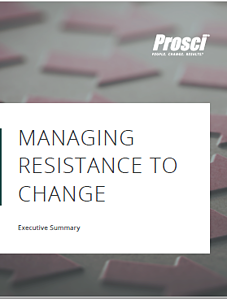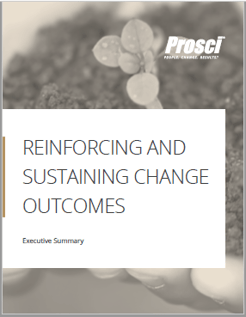Are you aware of how resistance is affecting your change initiatives? It's likely you're not but you might be aware of some dissent or passing comments in your weekly meetings to discuss a new or ongoing initiative. One of the most common mistakes an organisation makes during a transition period to a future state, is to ignore resistance to change. To tackle this, firstly we must explore the what's, why's and how's of change resistance.
In this blog we will look at:
- What is Change Resistance?
- The Different Types of Resistance
- What are the Symptoms of Resistance?
- Why does Resistance to Change Happen?
- How to Overcome Resistance
What is Resistance to Change?

Prosci® have described the process of change as going from the current state (the comfort zone), to the transition state (where change is happening) and finally to the desired future state (where the change is realised). The the future state at the beginning of your change journey is uncertain and nebulous and it is inevitable that you will encounter resistance from employees in your organisation.
Change resistance can rear it's head in a variety of forms such as: Fear, anxiety, reduced productivity, avoidance and being outwardly negative about the change.
However, resistance is a natural response to change and people are more inclined to gravitate towards the current state of process because it is safe and known. The unknown elicits a fear response in humans and thus, unless resistance is planned for the future state of change initiative will likely fail to meet expectations.
Many organisations are surprised by resistance and fail to see that it is something that can be utilised to improve your initiative rather than hinder it.
If however, resistance is ignored, your initiative will likely fail for a variety of reasons and cause a domino effect in your organisation. Such implications include: lower project ROI, extra costs, creating a history of failed change management and most importantly, losing valued employees.
The Types of Resistance to Change

Resistance to change can appear in many different forms which can be categorised into different types of resistance. It can manifest itself in a singular individual or on an organisational scale. The main types of resistance include:
Political Resistance
Political resistance occurs when employees think that there's a chance that they will lose something of value when the change is implemented.
Ideological Resistance
Ideological resistance to change is firmly rooted in an employee's beliefs. These employees may believe that a new direction violates the fundamental values held by the organisation.
Social Resistance
For example, you might experience social resistance within a tight-knit organisation. Managers may feel compelled to resist your proposed change if it means protecting their co-workers.
What are the Symptoms of Resistance to Change?
We now know what the main types of resistance there are, so how do we know when it's happening? There are some obvious signs and symptoms to look out for within an individual or a group of employees.
Resistance is evident in actions such as:
- Acting out – When an employee or group is acting out, they may cause conflict, be passive aggressive and even celebrate failure.
- Avoidance: When an employee is avoiding the change, they may, miss meetings, ignore the change and revert to old behaviours.
- Negativity: When an employee is being negative this may be shown by, objections, complaining and rumour spreading.
- Disengaging: When an employee is disengaged from the change, they may be quiet, indifferent and ignore communication.
- Control: When an employee tries to control the change, they will ask a lot of questions, defend the current state and try to influence outcomes.
- Building barriers: When an employee is building barriers, they can use excuses, recruit dissenters and use counter-approaches to resist the change.
Resistance to change can also manifest itself differently depending on the seniority of the individual. A manager or director might be more resolute in their stance against change and can significantly disrupt the progress of a change initiative if they are not on-board. If sponsor or people manager resistance is not addressed, failure is inevitable.
It is imperative that people managers have the competence to effectively communicate change. Prosci’s Best Practice Research tells us that employees want to hear business-wide messages from their CEO, but want to hear those WIIFM (what’s in it for me) messages from their direct line manager.
In terms of Prosci’s famous ADKAR (Awareness, Desire, Knowledge, Ability, Reinforcement) model for individual change, the desire to change is heavily impacted by the answer to the question, “what’s in it for me?”. Therefore, line managers have a hugely critical role in progressing their team through the stages of the ADKAR model, which in turn, contributes to the likelihood of project success.
Why Does Resistance Happen?

Resistance to change happens for a multitude of reasons, but ultimately, the main reason initiatives fail boils down to poorly managed change. So, how do we pinpoint why resistance is happening? We can start by taking a look at what part of the change management process is falling short.
Common “pain points” in change management, that can be a root cause of resistance include, but are not limited to:
- Sponsors not fulfilling their role effectively
- Lack of a common change management framework
- Lack of awareness of why the change has been implemented
- Lack of inclusion
- Fear of impact on job/job role
To learn more about how to identify root causes of resistance, take a look at CMC’s Webinar on managing resistance.
Free Download: Managing Resistance to Change

What Can We Do to Overcome Resistance to Change?

We now know why resistance can happen, what the root causes of it are and that it is a disruptive yet natural response to change. But how do we overcome it? We use the word 'overcome' not to mean stamp out but quite the opposite. Resistance can be a tool for improving the outcome of your change initiatives if properly planned for.
As mentioned previously in the blog, resistance ultimately occurs because of poorly managed change. Even if you were to plan for resistance, it will still appear for a variety of reasons, even the most positive change you can imagine, will still not please everyone.
Prosci offers two approaches to managing resistance for wherever you are in your change journey.
- Resistance prevention
One way to prevent resistance is to set out to manage change properly from the outset, we can then put measures in place to help manage resistance. Some examples of this include: engaging sponsors, equipping managers, and providing adequate training to impacted groups. If we do this, we give ourselves a solid foundation for successful change.
We also need to identify where to focus our change management efforts. To do this we need start thinking about where we can foresee pockets of resistance forming, note down particular individuals who are often resistant and groups or teams that are more negatively affected by the change than others.
If you are a line manager, you can also help prevent resistance to change in your team by hosting catch up meetings where people can air their grievances with the change. Read this blog to find out more about how best to conduct these conversations.
- Resistance Response
If resistance has already reared it's ugly head, you can still react in a targeted and timely manner to stop the resistance from spreading. Prosci have listed 3 steps to help address resistance if it is already occurring:
- Identify the root cause of the resistance through ADKAR® assessments (assessing the individuals current state in change)
- Once the root cause is identified, a range of activities come into play in order to listen to concerns and create a plan to help the individual move past their barrier point.
- Enable and empower resistance managers who will help you manage the resistance where it springs up.
We ideally want to address and plan for resistance before it becomes embedded in an organisation. Prosci have also listed 6 Tips to help you minimise resistance. These are:
- Communicate early and often
- Listen to employees
- Educate employees on the value of change
- Name emotions
- Timing is everything
- Provide ongoing support
Free Download: Reinforcing and Sustaining Change Outcomes

How do we future proof Change Initiatives against Resistance?

Wherever you are on your change journey, it is still imperative that we are equipped to deal with future resistance. So, what steps can we take?
Focus on your Line Managers
We mentioned earlier in the blog the importance of people managers in supporting and communicating with their direct reports throughout change. They are ‘key in building support and mitigating resistance during a change’.
Therefore, creating an environment where our line managers fully understand the change, and are 100% confident in their role, will go a long way to future-proofing future initiatives.
You may wish to consider organising a Prosci Leading your Teams Through Change Workshop for line managers in your organisation, so that they can be fully trained in how to support their direct reports through change.
Invest in change management
If you do not invest in change management properly, it will inevitably cost you.
Without change management that is well managed in your organisation, the likelihood that your projects and initiatives fail increases. If you do not manage change successfully, there are two possible eventualities:
- You will launch a separate project following the change project to drive adoption and usage, or...
- You will not launch a separate project, and the organisation will not achieve its return on investment
Investing in change management training and infrastructure is imperative because you will not only be future-proofing against resistance and achieving the desired outcomes, you will also save your organisation money in the long-term.
Start your Journey towards Enterprise Change Management
One major step towards future proofing your change initiatives against resistance, is to implement an organisational approach to change management (Known as enterprise change management), instead of implementing change management on a project-by-project basis.
Being harmonious in your approach across the whole organisation makes it easier to support and guide your employees through change and as a result, helps to mitigate resistance effectively. It also allows an organisation to be agile in a world of constant change.
We also offer private on-site training, contact us for more information.




